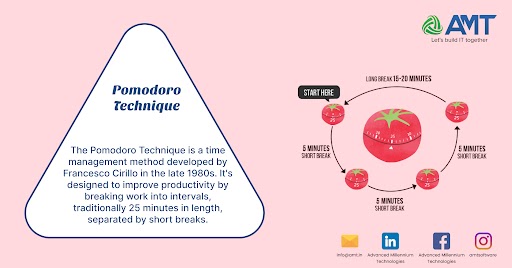The Pomodoro Technique is a time management method developed by Francesco Cirillo in the late 1980s. It’s designed to improve productivity by breaking work into intervals, traditionally 25 minutes in length, separated by short breaks. Here’s how it typically works:
- Choose a Task: Select a task you want to work on.
- Set the Timer: Set a timer for 25 minutes (this time period is called a “Pomodoro”).
- Work on the Task: Work on the task until the timer rings. Try to focus solely on this task during this time.
- Take a Short Break: When the timer rings, take a short break, usually around 5 minutes.
- Repeat: After the short break, start another Pomodoro (25 minutes of work) on the same task. After completing four Pomodoros, take a longer break, typically around 15-30 minutes.
The technique is named after the tomato-shaped kitchen timer that Cirillo initially used, “pomodoro” being the Italian word for tomato. However, any timer can be used.
The key idea behind the Pomodoro Technique is to break work into manageable intervals, maintain focus during those intervals, and take regular breaks to rest and recharge. This approach can help improve concentration and reduce the likelihood of burnout.
While the traditional Pomodoro interval is 25 minutes, some people find they work better with shorter or longer intervals, so feel free to adjust the timing to suit your own preferences and workflow. Additionally, the technique encourages tracking your progress and making adjustments as needed to optimize productivity.
Here are some additional details and tips about the Pomodoro Technique:
- Task Selection: Choose tasks that are well-defined and manageable within a single Pomodoro session. Break larger tasks into smaller, actionable steps to make them more achievable within the 25-minute time frame.
- Eliminate Distractions: During each Pomodoro, try to minimize distractions as much as possible. This might involve turning off notifications, closing unnecessary tabs or apps, and creating a conducive work environment.
- Focus and Flow: The Pomodoro Technique encourages deep work and entering a state of flow, where you’re fully immersed in the task at hand. Avoid multitasking and commit to concentrating on one task during each Pomodoro session.
- Adaptability: While the traditional Pomodoro interval is 25 minutes, you can adjust the length of Pomodoros and breaks based on your personal preferences and energy levels. Experiment with different durations to find what works best for you.
- Pomodoro Tracking: Keep track of your Pomodoros and breaks using a timer or a Pomodoro app. This can help you stay accountable and monitor your productivity over time. Some apps also offer features like task lists, statistics, and customizable settings.
- Regular Breaks: Taking regular breaks is essential for maintaining focus and preventing burnout. Use the short breaks between Pomodoros to rest, stretch, hydrate, or engage in activities that help you relax and recharge.
- Review and Adjust: At the end of each day or week, take some time to review your productivity and reflect on what worked well and what didn’t. Adjust your Pomodoro intervals, break durations, or task prioritization as needed to improve your efficiency and effectiveness.
- Combine with Other Techniques: The Pomodoro Technique can be complemented by other productivity methods, such as the Eisenhower Matrix for task prioritization or the Getting Things Done (GTD) methodology for organizing and managing tasks.
Overall, the Pomodoro Technique provides a simple yet effective framework for managing time, enhancing focus, and boosting productivity. Its flexibility and adaptability make it suitable for a wide range of tasks and work styles.
Above is brief about Pomodoro Technique. Watch this space for more updates on the latest trends in Technology.
